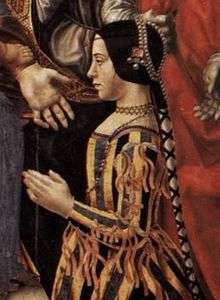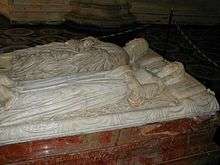Beatrice d'Este
| Beatrice d'Este | |
|---|---|
 Detail from the Pala Sforzesca, ca. 1494-1495. Currently in the Pinacoteca di Brera, Milan. | |
| Spouse(s) | Ludovico Sforza |
|
Issue | |
| Noble family | House of Este |
| Father | Ercole I d'Este |
| Mother | Leonora of Naples |
| Born |
29 June 1475 Ferrara, Italy |
| Died |
3 January 1497 (aged 21) Milan, Italy |
Beatrice d'Este (29 June 1475 – 3 January 1497), duchess of Bari and later of Milan, was the wife of the Milanese ruler Ludovico Sforza (known as "il Moro"). She was one of the most beautiful and accomplished princesses of the Italian Renaissance. A member of the Este family, she was the younger daughter of Ercole I d'Este and the sister of Isabella d'Este and Alfonso d'Este. Along with her sister, Beatrice was noted for her excellent taste in fashion and for having invented new clothing styles.[1]
Marriage
The Ferrarese house of Este and the Milanese house of Sforza had always been on friendly terms and in 1480, in order to cement an alliance, Ludovico Sforza formally asked Ercole d'Este to give him the hand of his daughter in marriage. Ludovico, who was then duke of Bari and regent to the duke of Milan, had originally requested a betrothal to Isabella, Beatrice's older sister, but because she was already promised to Francesco Gonzaga, Ercole offered him Beatrice instead.[2] Il Moro made no objection to the arrangement and Beatrice was married to him in January 1491.
The official nuptials were to have taken place in 1490 in a double wedding with Beatrice marrying Ludovico and Isabella marrying Francesco at the same time, but the Duke of Bari postponed it more than once.[3] Finally, around a year later, they were wed in a double Sforza-Este wedding: Ludovico married Beatrice, while Beatrice's brother, Alfonso d'Este, married Anna Sforza, the sister of Gian Galeazzo Sforza. Leonardo da Vinci orchestrated the wedding celebration.
Life and death as duchess consort
Beatrice had been carefully educated, and availed herself of her position as mistress of one of the most splendid courts of Italy to gather around her learned men, poets and artists, such as Niccolò da Correggio, Bernardo Castiglione, Donato Bramante, Leonardo da Vinci, and many others.

In 1492 she visited Venice as ambassador for her husband in his political schemes, which consisted chiefly of a desire to be recognized as duke of Milan. On the death of Gian Galeazzo Sforza, Ludovico's usurpation was legalized, and after the Battle of Fornovo (1495), both he and his wife took part in the peace congress of Vercelli between Charles VIII of France and the Italian princes, at which Beatrice showed great political ability.
However, her brilliant career was cut short by death through childbirth, on 3 January 1497 at the age of 21. In a letter written hours after her death, Ludovico informed his brother-in-law Francesco Gonzaga that his wife, "gave back her spirit to God" half an hour after midnight. Their child had been born at eleven at night and was a stillborn son.[4]
Legacy
Beatrice d'Este belonged to the best class of Renaissance women, and was one of the cultural influences of the age; to a great extent, her patronage and good taste are responsible for the splendour of the Castello Sforzesco in Milan, the Certosa of Pavia, and many other famous buildings in Lombardy. Her tomb is preserved in the Certosa di Pavia where she is buried beside her husband Ludovico Sforza.
Issue
Her children by Ludovico Sforza:
- Massimiliano Sforza (25 January 1493 – 4 June 1530), duke of Milan 1512–1515.
- Francesco II Sforza (4 February 1495 – 24 October 1535), duke of Milan 1521–1535.
- Stillborn son (3 January 1497).
Ritratto di dama
Beatrice d'Este is very often mistaken as the sitter of Ritratto di dama by Ambrogio de Predis at the Pinacoteca Ambrosiana in Milan. Investigations between 2010 and 2013 by Martin Kemp/Pascal Cotte and a German researcher brought to light strong evidence that the true sitter of the painting is not Beatrice d'Este but Anna Sforza.[5] A historically confirmed profile portrait of Beatrice d'Este can be found in the Pala Sforzesca. Another authentic document of Beatrice d'Este's appearance can be found in a bust by Giovanni Cristoforo Romano in the early 1490s.
-

Pala Sforzesca (1494) with Beatrice d'Este, kneeling on the right.
-
Bust of the young Beatrice d'Este by Giovanni Cristoforo Romano, c. 1490.
Literature
- In The Second Mrs. Giaconda, a novel by E. L. Konigsburg, her dull appearance is crucial. "She's small and dark and perfectly plain", the main character says when he first sees her; when they meet she is "trying to get the sun to make me blond and beautiful"; when she meets Leonardo da Vinci she laments her "plain brown wrapping"; and so on.[6] She overcomes her looks and after death one of her insights becomes a cause of Da Vinci's Mona Lisa.
- In the novel Duchess of Milan author Michael Ennis explores Beatrice d'Este's tenure as Duchess of Bari and eventually as first lady of Milan as well as her friendship and rivalry with Isabella of Aragon.
Ancestors
| Ancestors of Beatrice d'Este | ||||||||||||||||||||||||||||||||||||||||||||||||||||||||||||||||||||||||||||||||||||||||||||||||||||||||||||||||||||||||||||||||||||||||||||||||||||||||||||||||||||||||||||||||||||||||||||||||||||||||||||||||||||||||||||||||||||||||||||||||||||||||||||||||||||||||||||||||||||||||||||||||||||||||||||||||||||||||||||||||||||||||||||||||||
|---|---|---|---|---|---|---|---|---|---|---|---|---|---|---|---|---|---|---|---|---|---|---|---|---|---|---|---|---|---|---|---|---|---|---|---|---|---|---|---|---|---|---|---|---|---|---|---|---|---|---|---|---|---|---|---|---|---|---|---|---|---|---|---|---|---|---|---|---|---|---|---|---|---|---|---|---|---|---|---|---|---|---|---|---|---|---|---|---|---|---|---|---|---|---|---|---|---|---|---|---|---|---|---|---|---|---|---|---|---|---|---|---|---|---|---|---|---|---|---|---|---|---|---|---|---|---|---|---|---|---|---|---|---|---|---|---|---|---|---|---|---|---|---|---|---|---|---|---|---|---|---|---|---|---|---|---|---|---|---|---|---|---|---|---|---|---|---|---|---|---|---|---|---|---|---|---|---|---|---|---|---|---|---|---|---|---|---|---|---|---|---|---|---|---|---|---|---|---|---|---|---|---|---|---|---|---|---|---|---|---|---|---|---|---|---|---|---|---|---|---|---|---|---|---|---|---|---|---|---|---|---|---|---|---|---|---|---|---|---|---|---|---|---|---|---|---|---|---|---|---|---|---|---|---|---|---|---|---|---|---|---|---|---|---|---|---|---|---|---|---|---|---|---|---|---|---|---|---|---|---|---|---|---|---|---|---|---|---|---|---|---|---|---|---|---|---|---|---|---|---|---|---|---|---|---|---|---|---|---|---|---|---|---|---|---|---|---|---|---|---|---|---|---|---|---|---|---|---|---|---|---|---|---|---|---|---|---|---|
| ||||||||||||||||||||||||||||||||||||||||||||||||||||||||||||||||||||||||||||||||||||||||||||||||||||||||||||||||||||||||||||||||||||||||||||||||||||||||||||||||||||||||||||||||||||||||||||||||||||||||||||||||||||||||||||||||||||||||||||||||||||||||||||||||||||||||||||||||||||||||||||||||||||||||||||||||||||||||||||||||||||||||||||||||||
References
Notes
- ↑ Muralti, F. (1861). Annalia. Milan. p. 54.
Anno Christi MCDLXXXXVII Beatrix Herculis Ducis Ferrariae filia ac Ludovici Sfortiae Mediolani Ducis uxor hoc anno tertio ianuarii ex infelici partu suum diem clausit extremum, duobus post se natis masculis relictis; quae erat in iuvenili aetate, formosa ac nigri coloris, novarum vestium inventrix, die noctuque stans in choreis ac deliciis.
- ↑ Cartwright (1903), pp. 8–9
- ↑ Shell, Janice; Sironi, Grazioso (1992). "Cecilia Gallerani: Leonardo's Lady with an Ermine". Artibus et Historiae. 13 (25): 47–66 pp.57. doi:10.2307/1483456.
- ↑ Cartwright (1903), pp. 307–308
- ↑ Reimann, Sascha: "Ritratto di dama (Ambrosiana Milan) The Sitter – The Painter – New Evidences", s.l., December 2013; see also Kemp, Martin/Cotte, Pascal, 2010. La Bella Principessa. London: Hodder & Stoughton, p. 63.
- ↑ Konigsburg, E.L. (1975). The Second Mrs. Giaconda. Atheneum Books. pp. 38, 51, 59, passim. ISBN 0-689-30480-3.
Sources
- Cartwright, Julia (1903). Beatrice D'Este, Duchess of Milan, 1475–1497: A Study of the Renaissance. J. M. Dent.
External links
![]() Media related to Beatrice d'Este at Wikimedia Commons
Media related to Beatrice d'Este at Wikimedia Commons